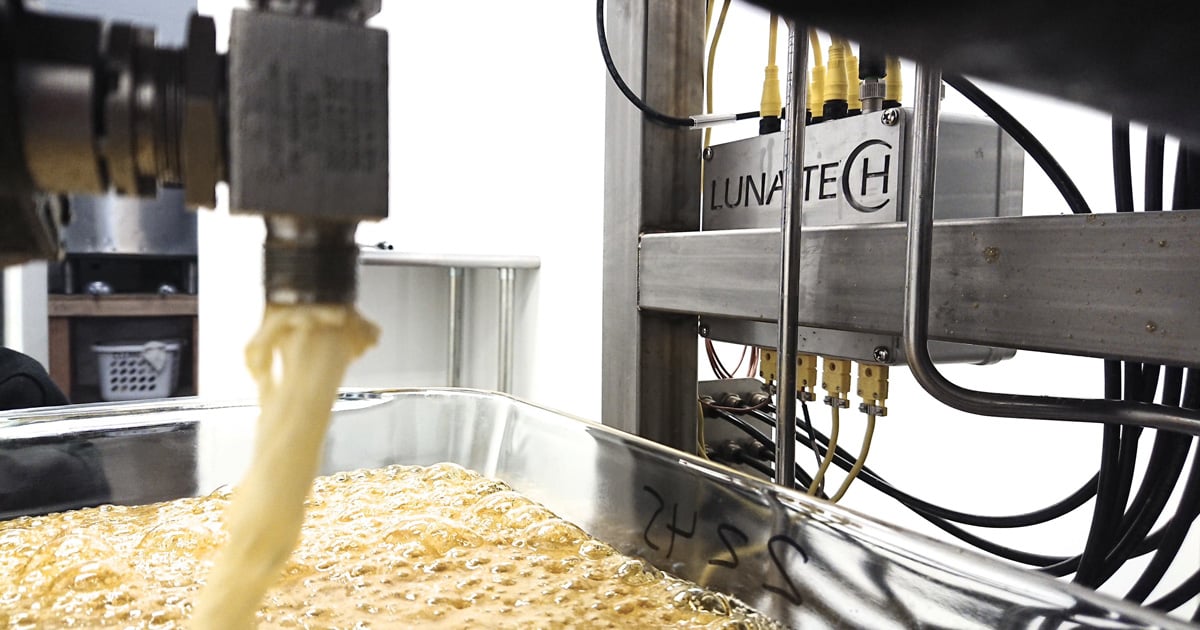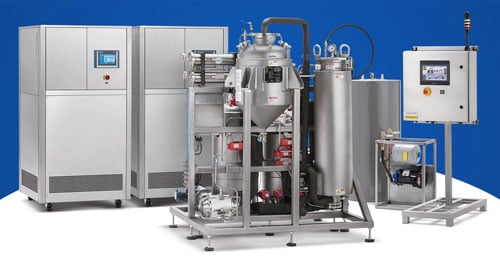Cannabis concentrates range in texture, potency, and quality, but each provides a concentrated form of medicinal and therapeutic compounds found in the cannabis plant. While many cannabis consumers only focus on a couple of cannabinoids (THC and CBD), the truth is that cannabinoid isolates pale in comparison to an extract that also contains terpenes and flavonoids. Aromatic terpene and flavonoid compounds contribute to more than just a strain’s smell. They interact with cannabinoids to amplify or mitigate certain effects.
Extraction methods in the past only focused on making high-potency extracts to be infused into oils, edibles, topicals, and more. Today, cannabis consumers look for tinctures, shatters, or waxes that have retained as much of the strain’s chemical profile as possible. Full-spectrum extraction methods produce cannabis extracts that cater to consumers looking for depth, purity, and complexity in their concentrates.

What Is Full-Spectrum Extraction?
Full-spectrum extraction, also known as broad-spectrum extraction, differs from other extraction methods in that the final product preserves the flavonoids, phenolic amides, and sterols while removing the plant material. Full-spectrum extracts like full-spectrum CBD contain the strain’s unique ratio of compounds that can enhance certain therapeutic effects. Extraction requires the application of light hydrocarbon solutions (butane or propane) to raw cannabis material at exact temperatures in a sealed vessel.
Through butane (BHO) extraction, the solvent strips away the plant’s cannabinoids and terpenes by binding to them. The solvent is then purged from the cannabinoid and terpene extract through a vacuum purge. State-of-the-art closed-loop extraction systems contain the solvent and even recycle it instead of letting it go to waste. Full-spectrum extraction may have expensive start-up costs but produces multiple full-spectrum forms (although not all BHO is full-spectrum).
- High-Cannabinoid Full-Spectrum Extract (HCFSE) contains a high concentration of cannabinoids like THC. THC in the extract gives it a sugar-like texture.
- High-Terpene Full-Spectrum (HTFSE) are translucent and viscous liquids that contain about 50% THCA and up to 40% terpenes.
- Sauce, also known as terp sauce, is a sticky – with a sometimes sugar-like consistency – extract with a high concentration of terpenes and cannabinoids.
- Live Resin refers to extracts made using frozen plant material right after harvest without going through a curing or drying phase to retain the full-spectrum benefits from the peak of harvest season.
- Shatter can be clear or opaque and have a glass-like consistency.
What Are the Alternatives?
There are many large-scale extraction methods available to growers and producers ranging in price, throughput, quality produced, and ease-of-use. Unlike full-spectrum extraction or BHO extraction, some methods filter out cannabinoids that aren’t as well known. CO2 extraction, for example, can produce a high-potency extract but loses the original terpene profile via the high-temperatures used. Manual extraction, on the other hand, produces bubble hash, dry sift, and rosin, but may retain fats and lipids that don’t contribute to the medicinal effects.
Some cannabis consumers turn to distillates or isolates that contain a singular cannabinoid without its other cannabinoid counterparts, terpenes, or fatty acids. A CBD isolate, for example, differs from broad-spectrum CBD or full-spectrum hemp oil in that it doesn’t undergo whole-plant extraction. Distillate can often include cannabis-derived terpenes or plant-derived terpenes to recreate the full chemical profile but is not considered full-spectrum. Full-spectrum refers to naturally-extracted as opposed to extracts with re-introduced terpenes.
What Are the Health Benefits of Full-Spectrum Extraction?
Full-spectrum extraction enhances the health benefits of an extract by preserving its complex range of chemical compounds. Other extraction methods can alter the compounds through decarboxylation or oxidation. Each cannabis strain, or cultivar, has a unique chemical profile that works synergistically to produce restorative effects. In order to understand why full-spectrum extraction provides enhanced benefits, consumers must understand how the compounds are created.
Cannabinoids and terpenes are found in the lipid and fat-based trichomes, primarily located on cannabis flower buds. While these compounds have not received the attention they deserve, they have been known to provide symptomatic relief. For example, cannabinoids like CBG and CBN are found in full-spectrum extracts like full-spectrum hemp oil or full-spectrum CBD. Studies have found that CBG and CBN feature anti-inflammatory, analgesic, neuroprotective, and anti-bacterial characteristics.
A study published by the Lautenberg Center for Immunology and Cancer Research even found that full-spectrum CBD provided effective relief at high doses, unlike CBD isolates. In the study, “the isolated CBD was ineffective both before and after a certain dosage.” Researchers concluded that CBD was effective against swelling and pain at certain doses. The rest of the cannabinoid and terpenes could provide more relief at higher doses.
The Entourage Effect
The entourage effect is the synergistic interaction between cannabinoids and terpenes that have been shown to elevate a user’s experience. With over 400 compounds in the cannabis plants, researchers have a long way to go in finding each compounds unique effects and how they interact with each other. Full-spectrum extracts take advantage of the entourage effect, and we are only just scratching the surface of understanding how each element contributes to another.
Full-spectrum health benefits derive from the natural ratio of compounds, but many full-spectrum products may not actually be full-spectrum. Cannabis consumers should always ask extractors for lab tests from an accredited analytical lab to ensure that their product contains more than just THC or CBD. Tests that can detect a complete list of compounds in a full-spectrum extract can be pricey but give consumers peace of mind knowing they are buying a safe and pure product.


